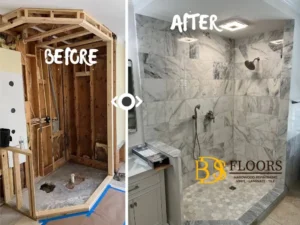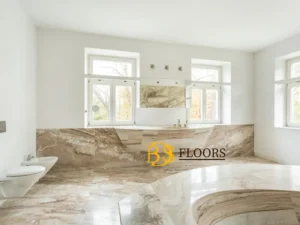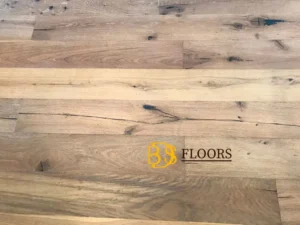Learn everything you need to know about waxing hardwood floors, the tried and true method for achieving a durable and glossy finish.
If your hardwood floors have lost their charm and are now lackluster, damaged or dirty, it can detract from the sophistication they bring to your living space. Fortunately, there is a cost-effective and reliable solution to revive them: waxing. Keep reading to discover the steps to waxing your floors and creating a stunning shine that will leave you feeling like you’re walking on clouds.
Why is it important to wax hardwood floors?
There are several reasons why waxing hardwood floors is crucial. This technique involves applying a thin layer of clear or colored wax, which is typically composed of solvents and a combination of natural and synthetic waxes (such as beeswax or carnauba), and then polishing it to create a glossy finish. As the solvents evaporate, the wax forms a durable seal that offers various benefits to the hardwood flooring. Here are some advantages of waxing hardwood floors:
By applying a wax seal to hardwood floors, it can provide numerous benefits such as:
- Improving stain resistance: The wax layer prevents spills from being absorbed and helps prevent staining on the floors.
- Minimizing minor imperfections: Wax can fade or eliminate the appearance of scratches, dings, and scuff marks, making floors look more even.
- Preserving underlying finishes: Wax creates a barrier that protects underlying finishes, such as oil, from dust, dirt, and spills. This helps prolong the life of the floor.
- Extending floor life: Waxed floors tend to be more resilient and can last for years longer than unwaxed floors if properly maintained.
- Enhancing beauty: Clear wax can give floors a glossy finish and a smooth feel that regular vacuuming or mopping cannot achieve. Colored waxes, available in natural brown hues, provide the same benefits plus an attractive tint that adds depth to the floor’s patina.
While wax can provide a protective layer, it cannot prevent deeper dents or gouges, nor can it protect against warping or bulging caused by extensive moisture exposure. Wax should be used as a final layer of protection, in addition to other protective finishes, for hardwood floors.

Is floor wax good for all floors?
When it comes to waxing floors, it’s important to choose the right type of flooring to apply it on. Hardwood floors that have been treated with a penetrating wood sealer, lacquer, varnish, shellac, or oil are the best candidates for waxing. The wax can enhance the protective properties of these finishes. However, unfinished floors can also be waxed.
It’s important to avoid waxing urethane-finished floors as it can prevent the urethane from being effectively recoated. Instead, polish should be used on these types of floors. Additionally, it’s essential not to apply floor wax on surfaces labeled as “no-wax,” such as no-wax linoleum or vinyl, which have factory coatings that do not require waxing.
It’s crucial to ensure that hardwood floors are in good structural condition without any significant chipping, gouging, discoloration, warping, or bulging before applying wax. If these issues are present, it’s recommended to repair or replace the affected floorboards first, such as sanding away discoloration or filling gouges with wood filler, before waxing the hardwood floors.
Which kind of hardwood floor wax should I use?
There are two main types of hardwood floor wax: solid paste wax and liquid wax.
Solid paste wax, like Minwax Paste Wax, is sold in cans and has a thicker consistency with more wax and less solvent. It is applied by hand with a cloth, which requires getting on your hands and knees, and needs fewer coats than liquid wax.
Liquid wax, such as Rust-Oleum Natural Satin Finishing Wax, is available in cans or bottles and has a thinner consistency due to containing more solvent. It is applied with a mop, making it a more convenient option for those who don’t want to kneel down, but requires multiple coats to achieve desired results.
When shopping for hardwood floor wax, be sure to look for the following terms in the product description:
- For use on floors: Avoid waxes labeled for use on furniture only as they may create a slippery coat on floors.
- Solvent-based: Opt for solvent-based waxes and avoid water-based or acrylic waxes which can cause finished floors to turn white or damage unfinished hardwood.
- Buffable: Look for traditional waxes that require buffing after application and avoid one-step or “no-buff” waxes which attract dirt.

How to Wax Floors
To wax hardwood floors, you need to complete three phases: surface preparation, application, and buffing. The following steps will help you complete each phase effectively:
Surface Preparation:
- Clear the room of furniture and rugs.
- Remove old wax by using a soft cloth dampened with mineral spirits or a commercial wax stripper, such as Trewax Heavy Duty Floor Stripper, over 2-foot sections of the floor at a time. Use fine-grade steel wool to remove stubborn wax build-up.
- Eliminate dust and loose wax build-up by dry-mopping (with a microfiber cloth pad) or vacuuming the floor with a dust brush attachment.
- If the floor is still dingy after dusting, use a store-bought cleaner like Bona Hardwood Floor Cleaner or a homemade cleaner made of one quarter-cup of dish soap and 1 gallon of warm water. Damp mop the floor with water to remove leftover cleaner and then dry it with a clean towel. Work in three-foot sections at a time.
How to Apply Hardwood Floor Wax
How to Apply Wax on Hardwood Floors Before applying wax on hardwood floors, make sure to wear gloves and a dust mask to protect yourself from fumes from the wax solvents. If you are applying solid paste wax, get into a comfortable kneeling position and use a putty knife and a soft, lint-free cloth. For liquid wax, stand and use a sponge mop for a faster application.
Take 1 tablespoon of solid wax with the putty knife and apply it on a soft, lint-free cloth. If using liquid wax, pour or squeeze 1 tablespoon directly onto the hardwood floor and dip the mop head into the wax. Work in 1- to 2-foot sections, spreading a thin layer of wax in the direction of the floorboards, starting from one corner of the room and moving towards an exit. Apply more wax to the cloth or to the floor until you’ve covered the entire room.
Allow the first coat to dry, which may take 10 minutes to an hour depending on the product. Apply additional coats as recommended by the manufacturer, allowing each coat to dry in between. Solid paste wax usually requires one coat over finished wood and two coats over unfinished wood, while liquid wax requires at least two to three coats, as each coat is much thinner.
Let the final coat of wax dry until hazy, and then it’s ready to buff.
How to Buff Waxed Wood Floors
To polish waxed wood floors, you can use a towel for solid wax or a sponge mop with a terry cloth head for liquid wax. Work in 2-foot sections and start in the same corner of the room where you began, buffing in the direction of the wood grain until you achieve the desired shine. Alternatively, rent an electric floor buffer/polisher from Home Depot for a faster process. This method can be used for both solid and liquid wax. After buffing, allow the waxed floor to settle for a minimum of 8 hours before walking on it or moving furniture back into the room.

How to Maintain Waxed Hardwood Floors
Here are some alternative ways to phrase the instructions for maintaining waxed hardwood floors:
- To keep your waxed hardwood floors looking their best, make sure to follow the manufacturer’s recommendation for re-waxing. If there is no recommended interval, you can test whether it’s time to re-wax by wiping a cloth dampened with mineral spirits over a small section of the floor. If the cloth comes away clean, it’s time to apply a fresh coat of wax.
- Be careful not to over-wax your floors, as this can create unsightly build-up. Wait until the old wax has worn off before applying a new coat.
- To keep your floors looking their best between waxings, buff them with a towel or sponge mop, as described above.
- Regularly dry-mop your waxed hardwood floors with a microfiber cloth pad or vacuum with a dust brush attachment to prevent dust from accumulating.
- Avoid using water to clean your floors, as it can damage the wood or cloud the wax. If you need to remove a spill, use a water-dampened cloth and wipe dry immediately.
- To remove stains or discoloration, use a hardwood floor cleaner and a cloth. Afterward, use a water-dampened cloth to remove any leftover cleaner and dry with a clean towel.
- Place rugs or mats at the entrance to your home to keep dirt from being tracked in and damaging your waxed hardwood floors.
- When moving furniture, lift it instead of dragging it across the floor to prevent dents and scratches.







